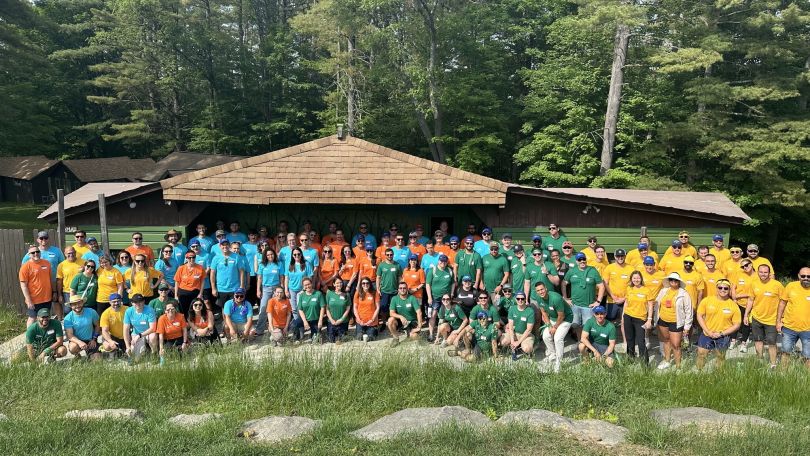When dev teams build new AI tools, products and platforms, they are faced with a unique challenge: How do you build the latest in AI when the field is rapidly changing every day?
It’s a little like trying to write a book while learning a new language and that language’s dictionary is doubling every three months.
So, we asked a handful of AI leaders how they're doing it.
According to Justworks’ Associate AI Product Manager Willy John VanSickle III, it’s all about teaching one another.
“Mentorship is important,” VanSickle said. “For instance, I regularly step in to help colleagues in departments like revenue operations build their own AI applications.”
The Justworks team also offers “AI office hours” and workshops for teams across the company to embrace experimentation and constant learning.
Meanwhile, the Qualtrics team spends ample time using their own AI sandbox to explore. Chief Engineering Officer Anderson Quach shared that, “Broadly, the Qualtrics team is hands-on in our own AI playground. We want the team to be confident with what AI can do and be pushing the boundaries of their own work through the use of AI.”
Built In spoke with 15 AI leaders about how their teams are innovating, continuously learning and striving to change their industries for the better.
Justworks is a cloud-based software platform that takes the busyness out of growing a business and alleviates the unknown.
What is the unique story that you feel your company has with AI? If you were writing about it, what would the title of your blog be?
Justworks’ story with AI has been about making meaningful changes to empower our entire workforce with education and enabling them to take their AI usage as far as they can as experts in their specific domains. To achieve this, we used both internal and external solutions and fostered adoption, empowering all to use AI to solve real business challenges. Our focus moved from cross-functional exploration hubs, which we called “AI Hives,” to a companywide strategic priority, emphasizing tangible tools that improve efficiency and provide insights for teams like sales, operations and product. We’ve built leveraging OpenAI’s APIs, and today every employee has full access to Google Gemini. We’re making it easier for everyone to analyze data — like understanding customer interactions to find unmet needs — by building custom tools that automate complicated internal processes (and we have a huge backlog!).
Our AI story has been about empowering our people to drive our mission and accelerate our business. We believe that the magic happens deep in the work, and so our path to impact with AI has been to arm the 1,400 people doing the work at Justworks rather than prescribe use cases top down.
What are you most excited about in the field of AI right now?
What excites me most is how AI development is becoming accessible to everyone. Starting in entry-level sales in 2022, I discovered this technology in October 2023 and felt an urgent need to build tools that improved my work. When Justworks began OpenAI testing, I was first in line. I asked ChatGPT for guidance — it told me to learn Python, do demos and embed myself in data. I dove in, copying code from ChatGPT into VSCode, quickly building sales tools. This led to our “AI Hive” experiment — six Justworkers from different departments tackling one problem using generative AI. Five prototypes and six weeks later, we sparked a trend that transformed my career (now AI product manager) and our approach to problem-solving.
Today, product managers code apps and sales teams use Python for lead generation. Colleagues who once found technology intimidating now collaborate to build AI tools to dig deep into customer feedback to drive deeper insights into what our customers truly need. I’m optimistic about this collaborative future where technical and nontechnical boundaries blur, creating an integrated workplace where everyone contributes meaningfully to our AI journey.
AI is a constantly evolving field. Very few people coming into these roles have years of experience to pull from. Explain what continuous learning looks like on your team. How do you learn from one another and collaborate?
Continuous learning is a core part of our data and analytics team’s culture. It involves both self-directed study — exploring new models, frameworks or development tools — and close teamwork. We learn consistently from each other through frequent meetings, working together on code and detailed code reviews with engineering colleagues. We actively share useful resources, code examples and findings in dedicated Slack channels and presentations.
Mentorship is important; for instance, I regularly step in to help colleagues in departments like revenue operations build their own AI applications. We also conduct programs like AI office hours and workshops for different teams, encouraging broader AI understanding and experimentation across Justworks. Collaboration extends beyond our team; key projects require deep partnerships with operations, product and sales, ensuring we learn and build together to meet business needs.
Qualtrics is an information tech company that created a platform that serves as a single system of record for companies to track all experience data, managing customer, product, employee and brand experiences.
What is the unique story that you feel your company has with AI? If you were writing about it, what would the title of your blog be?
We’ve been pioneering AI/ML within our category of experience management software for quite some time; the more recent GenAI wave has accelerated our efforts here. Our focus is on creating and developing capabilities that build customer and employee connections. These connections are what give companies a competitive edge, and it makes Qualtrics’s story pretty unique in a loud AI market.
A potential title could be “How AI powers world-class experience management” or even “Using AI to improve the human experience.”
Our company mission is to improve the human experience. That requires experience management — a purposeful design and development of experiences. AI, enabled with the right information, accelerates the ability to do that. Our AI solution helps our customers discover blind spots, identify the next trends, foster loyalty and enables them to take action in the moment while prioritizing security and privacy. Putting them — and us — on the road to making those improvements in the human experience.
What are you most excited about in the field of AI right now?
I’ve been most excited by the pace at which the state and capabilities of the technology are evolving rapidly. And with that we at Qualtrics are constantly thinking about how to evolve our software offering to best take advantage of these innovations and deliver even more value to our customers.
For example, at X4 we announced our entrance into experience agents: digital workers to help manage and resolve experience management issues. They’re the next era of XM and are extending the value of Qualtrics and XM, so it’s easy to be excited about their role in the market.
It’s been exciting to be building on top of the latest frontier models like OpenAI ChatGPT, Anthropic’s Claude, Meta’s LlaMA and more, leveraging large language models while evolving the state of experience management.
We’ve also been rapidly adopting and building with AI dev tools, seeing unprecedented productivity uplift with the use of code generation tools. Internally, we’ve been rapidly evolving our own internal dev tooling, having built over 20 internal apps to assist with trend analysis, issue analysis, development, testing and modeling.
AI is a constantly evolving field. Very few people coming into these roles have years of experience to pull from. Explain what continuous learning looks like on your team. How do you learn from one another and collaborate?
We’ve been actively working to upskill our current and incoming talent through a variety of learning and development activities.
Broadly, the Qualtrics team is hands-on in our own AI playground. We want the team to be confident with what AI can do and be pushing the boundaries of their own work through the use of AI.
In 2024 we brought onboard Gurdeep Singh Pall as our first-ever president, AI strategy. He brought with him over 30 years of experience creating new products and solutions with AI technologies. He spearheaded, among other things, Microsoft’s partnership with OpenAI, and in his time here has led AI strategy, including our recent entrance into experience agents.
Here in R&D we’re constantly actively hiring for the best talent in AI/ML.
Internally, we’ve also been running maximum likelihood estimation programs which aim to integrate ML engineers into our existing scrum teams, upskilling secure data exchanges.
We’re also constantly experimenting and learning. We run annual AI summits, bringing together hackathon-style demos and discussions, and we also run regular hackathons in engineering.
Workrise is a source-to-pay solution built for energy companies and suppliers to work together.
What is the unique story that you feel your company has with AI? If you were writing about it, what would the title of your blog be?
I’d say our story is about starting with the layups and expanding methodically, both in the product and internally, by giving our team the right tools and support to bring real value to our clients. We looked hard at what we’d built and found clear spots where AI could replace or improve it, like automating document extraction tasks. If we were writing about it, I would say the title of the blog would be “Validating AI Use Cases Through Fast, Focused Prototyping.” What makes our story unique is the industry we’re in and the massive opportunity AI opens up here. Trust and accuracy around client/vendor transactions and time tracking in the energy industry have always been tough. AI lets us handle both structured and unstructured data faster, more accurately and at scale.
What was a monumental moment for your team when it comes to your work with AI?
A key moment for us was realizing how fast applied AI could improve tasks we’d been handling with custom, templated workflows. Early on, we focused on no-brainer use cases — areas where AI models were already strong. We ran quick tests and right away saw legitimate gains in speed and accuracy. It wasn’t plug-and-play — we still had to tailor it to our needs — but it proved the value quickly and guided us toward investing further in that space. That led to a shift in how we work: we now emphasize fast, focused experimentation. Build proof of concepts, validate them and either scale or move on. That mindset helps us spot the right problems to solve without getting stuck chasing AI just for the sake of it.
What challenges did your team overcome in AI adoption?
Our leadership has been really supportive in this space, both for our small AI team and our employees who are leveraging the tools we’ve built or deployed for them. We try to keep model and provider bias low and develop a code architecture that allows us to plug and play the latest models and releases from any provider into our current workflow and get results almost immediately after the models become available.
That’s one way we try to keep up, but I won’t sugarcoat the current state of AI. It’s moving at breakneck speed and it’s challenging to keep up with. It requires a lot of blog reading, experimentation, knowledge sharing and what feels like a constant check on your understanding and bias. For example, model context protocol servers are in the category of a new hot trend in AI, and as we’ve started experimenting, other solutions or tools that we have spent a lot of time and effort on are rendered out of date or not reasonable to use given the existence of new AI trends, features or capabilities.
JumpCloud’s mission is to provide simple, secure access to an organization’s technology resources from any device, or any location.
What is the unique story that you feel your company has with AI? If you were writing about it, what would the title of your blog be?
JumpCloud’s unique AI story starts with the reality that we work in a complex, multifaceted domain — managing identities, devices, access, LDAP, RADIUS, SaaS tools and more. AI became a key tool not for doing the same work with fewer people, but for enabling the same team to do ten times more without being overwhelmed. It helps us make sense of large, interconnected systems quickly, contribute to unfamiliar projects and turn ideas into working solutions faster. A fitting title might be “Amplifying Impact: Using AI to Thrive in Complexity at JumpCloud.”
What was a monumental moment for your team when it comes to your work with AI?
One monumental moment was when we started using AI primarily for code editing. It immediately made mundane tasks like formatting, refactoring and writing boilerplate code faster, easier and more reliable — freeing us up to focus on the harder problems. Another key moment was during new hire intakes: AI’s ability to parse and analyze thousands of lines of code helped new engineers onboard more efficiently. And since documentation can quickly become outdated, using AI to generate up-to-date diagrams and flow visuals, then reviewing and signing off as a team, became a game changer. These use cases showed real, practical value — AI combined with human judgment made us significantly faster and more effective.
What challenges did your team overcome in AI adoption?
Initially, integrating AI felt overwhelming — many on the team, especially senior engineers, were skeptical about its real-world value. Others, often juniors, expected it to do everything from debugging to writing entire modules. We focused on tools like GitHub Copilot to bridge the gap and demonstrate how AI can assist, not replace. Prompting became a core skill — figuring out how to ask the right questions to get meaningful, usable help. Over time, this built trust and practical understanding.
A big part of this shift came from having a general #gen-ai Slack channel. People shared everything — from Studio Ghibli-style AI photos to real stories of how AI made their work easier or more efficient. It sparked creativity and inspired others to try new workflows. Now, AI adoption is companywide, and we’re even hosting AI-focused hackathons across teams.
VSCO is a platform that equips photographers with tools, community and exposure to expand creatively and professionally.
What is the unique story that you feel your company has with AI? If you were writing about it, what would the title of your blog be?
I work at VSCO, a platform committed to helping photographers thrive, and we use AI in a number of ways. Firstly, like a lot of technology companies, we’re increasingly using AI to improve the work we do day to day. We are also using AI to build new and differentiated product features to delight our community of photographers.
While our use of AI has emerged recently, VSCO has been around for over a decade, which means lots of data. While access to a vast corpus of high-quality photography has been an asset for us, we’ve gotten the most value by focusing on our creators and the challenges they face. AI can be a powerful tool, but to advance a business, that tool must be aligned with the needs of the customers. The story of AI at VSCO is one of being relentlessly obsessed with the needs of photographers across the world.
What are you most excited about in the field of AI right now?
My feeling is that the speculation that advancing AI technology will lead to the demise of software engineers is overstated and wrong. What we’re seeing is that AI can be a multiplier on the impact a software engineer has. By helping think through the trickier aspects of problems and handling the repetitive or time-consuming aspects of coding, software engineers and technologists can think more about their work at a higher level, thinking more about the forest and less about the trees. That elevation in perspective means more impact and value to our community.
In the same way, AI also has the potential to be a great help to the photographers who rely on our platform. We’re inspired to build a new generation of AI-powered tools to help the photographers who use VSCO thrive. By streamlining the more repetitive or time-consuming aspects of the photographic creative process, helping photographers looking for work connect with those looking to hire photographers and providing a vibrant creative community, AI can elevate and empower photographers to a higher level.
What challenges did your team overcome in AI adoption?
The technology ecosystem is changing so fast that it’s difficult to keep up. AI and LLM-based assistants have been a huge accelerant to our work, but each new tool is a change. Making space to explore new advances and identify new tools has been critical. It’s also important to give time to learn and adjust to the new ways of working that AI tools provide. To take the greatest advantage of the evolving ecosystem, we need to emphasize flexibility in how we approach problems and make sure there’s time to learn and adjust as our tools change. The world of AI is also a bit of the wild west, and it’s important that we understand the risks and benefits when adopting new technologies.
This fluidity of tools can be a mental shift for technologists — professionals who often have a strong connection with the tools they work with — but the results, the impact of new AI on productivity, is undeniable. Show-and-tell has been a key driver in socializing awareness and inspiration. It’s so motivating to see a colleague demo for the team how they used an LLM coding agent to make their hard problems incredibly easy — and you can do it, too.
Motorola Solutions creates communication solutions and technology designed to create safer communities and cities.
What is the unique story that you feel your company has with AI? If you were writing about it, what would the title of your blog be?
My blog would be titled, “Meeting You Where You Are.”
At Motorola Solutions, we understand AI isn’t a one-size-fits-all approach. Each unique role has a distinct way of processing information and understanding this allows us to shape our solutions to address our customers’ unique needs.
Given the critical nature of public safety, our AI is thoughtfully designed to assist and inform rather than distract. For example, 911 call takers’ priority is to gather essential information quickly and accurately to dispatch the appropriate help. We design AI to help collect this in a simple “who, what, where, when, why and how?” format. On the other hand, officers require in-depth documentation for record-keeping. Our AI is designed to help craft a detailed timeline, leveraging multiple streams of information and arranging it into the same agency template officers use. By implementing familiar design patterns, we establish trust between the user and our technology.
Our goal isn’t to simply inject AI anywhere into our technology; it’s to have AI conform to the human way of taking in information. We have the responsibility to meet you where you are.
What was a monumental moment for your team when it comes to your work with AI?
Motorola Solutions recently launched SVX and Assist, a first-of-its-kind video remote speaker microphone that converges secure voice, video and AI designed for our APX NEXT radio. SVX combines a body camera and radio into a single device and Assist places the power of human-AI collaboration directly into their hands.
Assist can query a license plate or driver’s license and automatically search for associated records or warnings, detect keywords in radio traffic such as “shots fired,” alert nearby officers and command center staff, and act as a live language translator between officer and community member.
Assist also targets some of officers’ most time-consuming work. Our research shows that patrol officers spend 40-60 percent of their time when writing reports entering basic data about people, vehicles and property. By collating data from radio conversations, officer’s location, 911 call information, camera footage and more, Assist augments an officer’s individual perspective. Officers’ time is preserved so they can spend more of it in their communities, confident in their factually grounded reports and evidence.
This launch establishes the path forward for AI in public safety.
AI is a constantly evolving field. Very few people coming into these roles have years of experience to pull from. Explain what continuous learning looks like on your team. How do you learn from one another and collaborate?
AI is more than a science — it’s an art. In the beginning, AI was something we added to our existing technology; it was the sugar we sprinkled into our coffee. But as the field evolved, so has the art form, and now AI has become the medium that we use … the coffee itself, so to speak.
With this shift, it’s imperative we design responsibly. Even with AI automation, we design for our users to maintain control.
Our teams enable this by prototyping our solutions much earlier in the design process. Customer testing is more iterative and our design teams work side by side with engineering and business teams to understand the possibilities. For SVX, we conducted research and usability testing with 32 agencies across 16 states.
This is what I love about Motorola Solutions — creativity is encouraged. I’m never afraid to propose new ideas because our teams are always eager to test them. This inherent positivity and spirit of innovation allows us to push the limits and create magic — in SVX and Assist and across the company.
Navixus helps enterprise-level companies solve complex CX and contact center problems.
What is the unique story that you feel your company has with AI? If you were writing about it, what would the title of your blog be?
The title of my blog would be “AI: Keeping Up Isn’t Good Enough.”
Humans expect instant access to information — whether it’s our PCs running numerous applications at once to produce and leverage documentation, voice-activated home devices or the technology we carry in the palm of our hands. We consume information at an incredible rate, especially in customer service, where answering the right questions at the right time in the right way is crucial. At Navixus we specialize in customer service — many of our leaders are former customer service operators, so we understand the challenges these executives face in staying ahead and the pressure to constantly innovate and improve.
What are you most excited about in the field of AI right now?
All of it! This is such a great time in human history to be alive, with AI offering us the chance to discover, learn and improve — at speed and scale. AI has the potential to revolutionize industries by positively impacting life expectancy in healthcare, effecting the preservation of natural resources or altering the generation of wealth, for instance. While AI has existed for decades, its true potential is now being seen, leading to innovations that will transform our world, from self-driving cars to smart cities, bringing sci-fi dreams into reality. It’s exciting!
AI is a constantly evolving field. Very few people coming into these roles have years of experience to pull from. Explain what continuous learning looks like on your team. How do you learn from one another and collaborate?
My biggest piece of advice for anyone exploring AI is to be curious. This applies to us individually as well as our teams. My job as a team leader is to provide opportunities and learning platforms for the team to collaborate, learn and grow together. In consulting, we often work with clients in a variety of industries whose AI initiatives are not performing as expected. There’s no better way to learn than to dive in, solve challenges together and build valuable experience.

Augury’s mission is to provide manufacturers and other industrial sectors with insights into the health of machines, processes and operations to transform how people work and what they can create.
What is the unique story that you feel your company has with AI? If you were writing about it, what would the title of your blog be?
Augury stands as a true pioneer in industrial AI, bringing genuine artificial intelligence to manufacturing maintenance and reliability. These sectors face immense modernization challenges where simply having AI models isn’t enough — you need rugged hardware, intuitive software that factory workers will actually use an expert-level service. Your AI must achieve accuracy levels orders of magnitude higher than in more forgiving markets, and scaling globally across diverse factories adds exponential complexity.
Yet we, at Augury, have succeeded, deploying reliable AI that eliminates machine failures, improves production and makes people ten times more productive in thousands of factories worldwide. Because of our focus on accuracy and reliability of vertical AI, our new AI agents now have the strongest possible foundation to provide value that’s rooted in accurate results, not hallucinations. The core story is about pushing the boundaries of what people and machines can achieve together — transforming industrial operations through AI that truly works in demanding real-world environments.
My blog title would be: “Pushing the Boundaries of What People and Machines Achieve Together.”
What was a monumental moment for your team when it comes to your work with AI? What are you most excited by in the field of AI right now?
Augury has achieved several significant milestones while building and leading the machine and process health categories in industrial AI. Three achievements stand out:
First, reaching 99.9 percent diagnostic accuracy across tens of thousands of industrial assets validated our AI models at scale, enabling our AI agents to provide truly reliable expert-level guidance for customers.
Second, surpassing $1 billion in quantified customer value demonstrated the tangible impact of our platform on manufacturing operations worldwide.
Most personally meaningful was when a reliability professional with 30 years of experience told us Augury was the single best thing to happen in his career. Knowing thousands of maintenance specialists rely on our insights daily — performing hundreds of thousands of actions based on our AI — brought home the real-world significance of our work in transforming the industry.
What challenges did your team overcome in AI adoption?
Manufacturing professionals demand unwavering reliability from new technology — if our solution faltered even once, trust evaporated. Initially, skepticism ran high as maintenance teams accustomed to reactive workflows doubted AI could deliver consistent, actionable insights.
We overcame this by refining our models and hardware integration to achieve error rates low enough for industrial environments. But technical excellence alone wasn’t sufficient. We built a team of domain experts who partner directly with customers — guiding onboarding, interpreting AI insights and tailoring best practices to real-world conditions.
We discovered adoption hinges more on engagement and change management than on technology itself. That’s why we invest just as much in user engagement, training and support as we do in developing features. By combining reliable AI with hands-on expertise and exceptional customer success, we’ve transformed skepticism into confidence — turning early adopters into passionate advocates.
Elevate K-12 is an edtech company that brings equity in education to all students and teachers, irrespective of ZIP code. Elevate K-12 uses hiring practices that promote diversity.
What is the unique story that you feel your company has with AI? If you were writing about it, what would the title of your blog be?
Our company’s unique story with AI is one of transformative innovation and empowerment. It all began with a vision to elevate innovation and transform the way we work and live. With MS Copilot, we revolutionized productivity by providing intelligent assistance that seamlessly integrates into our daily tasks, making work more efficient and enjoyable.
Our AI-driven customer support systems redefined the customer experience, offering instant, accurate and personalized assistance, ensuring customer satisfaction and loyalty. We developed advanced conversational agents that provide seamless access to business data, enabling informed decision-making and driving business success. In education, our AI tools empower teachers by automating administrative tasks, providing personalized learning experiences and enhancing student engagement. Our unique AI story is one of continuous innovation, where technology meets human potential, creating a future where possibilities are limitless.
If I were to write a blog about it, the title would be “Elevating Innovation: Our Journey with AI and Beyond.”
What are you most excited about in the field of AI right now?
What excites me most is the speed of innovation in AI. Such speed and scale is unheard of in the history of humankind. This is unlocking capabilities that were previously unthinkable. AI is going to revolutionize education, and we can already see the early signs of it. In the next two to three years, personalized learning will become more prevalent. AI can analyze students’ learning patterns and tailor educational content to suit their individual needs, making learning more effective and engaging. Secondly, AI-powered tools will assist teachers in grading and providing feedback, freeing up their time to focus on more interactive and creative teaching methods. Additionally, AI will enable virtual classrooms and remote learning, making education accessible to students worldwide regardless of their geographical location. Lastly, AI will facilitate the development of intelligent tutoring systems that can provide instant support and guidance to students, enhancing their learning experience. The future of education with AI is bright and full of possibilities.
What challenges did your team overcome in AI adoption?
Before our team adopted AI, we faced several challenges that slowed our progress. Initially, there was a lack of understanding and skepticism about AI’s potential benefits. Many team members were unsure how AI could be integrated into our existing workflows and feared it might replace their roles.
One specific example was the implementation of a conversational AI agent for data access. Before its adoption, accessing data was a cumbersome process for business, requiring manual searches and queries. This led to inefficiencies and delays in decision-making.
To overcome these challenges, we took a proactive approach. We organized workshops and training sessions to educate the team about AI and its advantages. We encourage teams to share their AI accomplishments and incentivize adoption. This helped build confidence and enthusiasm among the members. We also collaborated closely with AI experts to address technical hurdles.

BigTime Software is a private equity-funded company with offices in Chicago, Phoenix, Boston and Poland committed to helping clients run their professional services firms more efficiently.
What is the unique story that you feel your company has with AI? If you were writing about it, what would the title of your blog be?
BigTime has truly embedded AI into how we think, build and deliver value, both internally and for our clients, and our unique story is one of rapidly paced evolution and relentless experimentation. There are many exciting aspects of BigTime’s AI journey coming to fruition at this moment, such as the BigTime AI Assistant, Build AI Report Builder, AI-powered task-based resourcing in Foresight, with much more on the horizon. But these enhancements wouldn’t exist without the culture we’ve built around AI.
We leverage tools from Google and OpenAI not only to enhance our daily workflows but also to better understand how our clients use them. Rather than waiting for perfect use cases to emerge, BigTime urges us to move fast and learn faster. We run internal AI hackathons, host monthly AI tool enablement sessions (ex: ChatGPT, NotebookLM, custom GPT creation) and established a cross-functional AI Champions employee group that convenes with other companies to share and collaborate on the AI space.
And if I were writing about BigTime’s unique story, the title of the blog would be “DNAi: BigTime’s AI Evolution in PSA.”
What was a monumental moment for your team when it comes to your work with AI?
A monumental moment for our team came when we rolled out the BigTime AI Assistant to general availability. We had been testing it internally for months, watching its knowledge retrieval and conversational capabilities steadily improve. But when it went live for clients, it felt like we had activated a veteran BigTime employee.
It was amazing to see the immediate impact of near-instant responses to common support questions, capable handling of alternative workflows and a visible reduction in tickets routed to our support team. Seeing questions I’d seen flood our support queue in the past now answered seamlessly was a powerful “wow, what’s next?” moment. Beyond support, the BigTime AI Assistant also transformed our onboarding experience, helping new clients and internal new hires alike get accurate answers without waiting. Our onboarding program is fantastic, but it’s hard to have a human available 24/7. Now BigTime AI Assistant is!
What challenges did your team overcome in AI adoption?
One of the biggest challenges we faced in adopting AI was rethinking how to test it. How do you get a grip on something as fluid and subjective as testing something’s intelligence — especially technology? In traditional software, testing is straightforward with clear workflows, expected behaviors and boundaries to validate success. AI, and especially conversational AI, doesn’t operate like that. It faces an almost infinite range of inputs, scenarios and a user set with their own approaches and hesitations in adopting this technology.
People and qualitative data can be a bit messy. So when it comes to testing AI, there is no standard best practice automated test case. At BigTime, we tackled this by building a new, more involved kind of QA process. We developed limited, scenario-driven test cases that could approximate real-world usage and even used AI itself to help generate edge cases and test inputs. It continues to be an ongoing effort without a real one-and-done checklist, but these iterations and improvements are building a standard of confidence in validating our AI products.
Apex Fintech Solutions provides the tools and services that enable hundreds of clients to launch, scale, and support digital investing for tens of millions of end investors. The company provides essential infrastructure and a comprehensive ecosystem of cloud-based products to enable and streamline trading, wealth management, cost basis, tax reporting, and, through its subsidiary Apex Clearing™, custody and clearing.
What is the unique story that you feel your company has with AI? If you were writing about it, what would the title of your blog be?
At Apex, we are committed to making investing accessible to everyone, and we bring that same inclusive ethos to our adoption of AI. The story of our AI journey is rooted in a transformative cultural shift, one led from within through our groundbreaking AI Ambassador Program. This program empowers employees across all functions, technical or not, to adopt and innovate with AI tools in meaningful ways, driving tangible business impact. With a world-class AI team leading the charge, we continuously develop tailored applications of widely available large language models and seamlessly integrate them into our existing systems, ensuring that all employees are equipped with the tools, education and support they need to leverage AI effectively.
What was a monumental moment for your team when it comes to your work with AI?
AI has been a game-changer for our engineering teams, particularly when it comes to streamlining and optimizing the software development process. One pivotal milestone has been the implementation of Apex-compliant AI bots, powered by advanced large language models, alongside our enterprise integration with GitHub Copilot. These tools have revolutionized the way our developers debug errors and test code. Tasks that previously required hours of manual effort — such as identifying bugs or ensuring edge cases and race conditions are accounted for — can now be handled with remarkable efficiency.
What sets our AI tools apart is their seamless alignment with our internal systems. By safely integrating them into Apex’s secure ecosystem and connecting them directly with our repositories, we’ve created custom AI assistants that provide unparalleled context to our development teams. The results? Faster debugging, improved accuracy and heightened productivity. They’re not just tools — they’re game-changers revolutionizing how we develop, test and deploy technology.
What challenges did your team overcome in AI adoption?
One of the largest challenges in adopting AI is keeping pace with its rapid evolution. At Apex, we’ve addressed this by fostering a culture of continuous learning and collaboration, ensuring all employees — whether deeply technical or entirely new to AI — feel comfortable engaging with and leveraging the tools available to them.
Through the AI Ambassador Program, team members participate in upskilling sessions led by our AI leadership. These sessions focus on the latest tools, technologies and best practices, empowering ambassadors to not only adopt AI themselves but also champion its adoption within Apex. Beyond formal training, one-on-one collaboration and brainstorming sessions between technical and non-technical employees have been invaluable. These collaborative environments ensure that even those with minimal technical expertise can contribute meaningfully — for example, building personalized AI assistants via our intuitive user interface with little to no coding required. The result is an inclusive approach to AI adoption, where everyone is empowered to experiment and innovate, whether they’re creating solutions for complex system challenges or simply streamlining everyday tasks.
RapDev helps customers become leaders in the race to deploy code faster as they upscale their operations.
What is the unique story that you feel your company has with AI? If you were writing about it, what would the title of your blog be?
Advancements in AI are becoming larger and more frequent by the day. There’s no shortage of bold claims about what it can do, and while the conversation often swings between hype and hesitation, the real story lies somewhere in between. We here at RapDev are happy positioning ourselves right in the middle. We’re ServiceNow Elite and Datadog Premier partners, so we have the best seats in the house watching how businesses try to adapt. The enthusiasm is real. Leaders want to leverage AI, improve efficiency and future-proof their operations. But the challenge lies in leveling that ambition with the rigid systems they have relied on for years — sometimes decades.
It’s not that businesses are resisting change. It’s that change is difficult when day-to-day operations require predictability, stability and compliance. If we were to write a blog, I’d want to title it “Mind the Gap: Pushing Dreams to Prod” since we’re positioned to turn big dreams into impactful outcomes.
What was a monumental moment for your team when it comes to your work with AI?
The shift from “what can we automate?” to “what kind of decision-making can we replicate?” was a massive one. The immediate draw of AI is to automate processes, but processes could already be automated. That wasn’t new. We had to step back and break down how we approach problems as engineers so we could onboard a large language model to sit in the seat next to us and trust it to do the job just as well.
Suddenly, we’re not measuring success based on code reaching the end of its flow without erroring out. We’re measuring how well an agent can understand intent, adapt to variation and make a decision that has you responding with a nod, “I was thinking the same thing.”
What challenges did your team overcome in AI adoption?
Our customers’ challenges are also our challenges. When we encounter highly manual or rigid processes, they’re not just inefficiencies we can work around or even fix. They’re shared pain points that we feel too, as they’re often too complex or nuanced for static scripting to handle effectively.
Sighing and saying, “there’s got to be a better way to do this,” is a tale as old as time — but AI has changed the rules. Challenges that once felt invincible, the kind that would eat as much code as you’d throw at them, suddenly become solvable when you can develop solutions that adapt to the messiness of the real world. Where we used to see barriers, we’re now seeing possibilities.
Smartly is an AI-powered advertising technology company transforming ad experiences for brands and their consumers.
What is the unique story that you feel your company has with AI? If you were writing about it, what would the title of your blog be?
Smartly’s relationship with AI isn’t a recent bolt-on — it’s the spine that has held our platform together since day one. Because we serve the entire advertising journey, our machine learning layer has context across both the creative and media sides of a marketer’s world. That dual vantage point lets us extract insights, scale creatives and optimize media with a holistic view.
When generative AI exploded onto the scene, we didn’t scramble to retrofit; we accelerated. Today, Smartly uses AI to help you go from idea to ad and powers workflows such as pulling a product page, generating on-brand backgrounds, crafting copy variations based on your brand voice, assembling channel-specific aspect ratios and optimizing campaign budgets — often before a human could have built the first brief.
The result for our customers is measurable: faster launch cycles, leaner production budgets and media spend that continuously self-optimizes. Our unique story is simple: Smartly goes beyond isolated AI features by powering the entire marketing engine — transforming sparks of inspiration into business outcomes at high speed and scale. Our blog would read: “From Idea to Ad and Beyond.”
What was a monumental moment for your team when it comes to your work with AI?
A key milestone for our AI work came when we launched the Smartly AI Studio in general availability earlier this year. With that release, our customers gained practical tools to transform a single static asset into channel-ready videos, build ads straight from a URL at scale, reshape raw footage into new narrative cuts and much more. We’ve seen a 30x increase in productivity and 27 percent improved performance in our AI Studio case studies, and we’re excited to be improving on these gains going forward.
Looking ahead, we’re focused on extending those gains beyond creative production. Two examples of such improvements include AI search and conversational insights. AI search adds a multimodal layer over historical assets and results. A natural-language query like “Christmas-themed holiday videos” now surfaces the relevant creatives in seconds. Conversational Insights offers a chat interface for performance questions. Rather than dig through metrics and reports yourself, let AI do the work and surface the insights automatically.
Our next chapter at Smartly is about turning AI from a feature into a steady partner in solving more complex challenges and workflows.
Continuous Learning at Smartly
Continuous learning on our AI team is anchored in four deliberate habits:
- Curate the signal. We keep an eye on LinkedIn, Twitter, company blogs, specialist newsletters and in-person tech events and conferences. Folks share their learnings with the team and other stakeholders.
- Dedicate time for experimentation. We block off recurring experiment windows for proofs of concept and mock-ups. These sessions let us test ideas to assess feasibility and initial customer reactions before diving deeper into hardening and productionizing the feature.
- Build shoulder to shoulder. Smartly’s data scientists, product engineers and ML engineers work in one thread — from prototype to production. We have development practices and a platform that shortens the path between discovery and a shippable feature.
- Close the loop with customers. Early versions go into the hands of select clients who can give us meaningful feedback on the product offering so we can iterate and improve in what truly matters.

With a platform that connects providers and payers, Cedar empowers healthcare consumers with a personalized journey from appointment confirmation to payment — all powered by data science and interactive design.
What is the unique story that you feel your company has with AI? If you were writing about it, what would the title of your blog be?
Cedar’s AI story is one that’s familiar to all of us — the patients who face the nearly universal experience of receiving healthcare and managing what comes next: the bill. To deeply understand these needs, my team built a large language model-powered pipeline that transcribes and parses thousands of patient call recordings to gather the insights and data that fuel our AI voice agent, Kora. Kora provides patients with comprehensive and compassionate medical billing support, delivering personalized guidance on everything from balance inquiries to payment options — even when patients can’t fully articulate their problem.
Our blog title would be: “The AI That Listens When You Don’t Know What to Say.” Healthcare billing is an area where users are often confused, anxious and unsure of the exact problem they are facing. It’s why building AI for healthcare is different from typical consumer applications. Our patients aren’t looking for a specific product code or a simple return process — they need guidance, diagnosis and a path to resolution.
What was a monumental moment for your team when it comes to your work with AI?
One monumental moment occurred last year, when we released our AI chat assistant and were overwhelmed by positive feedback from the users of the product — call center agents who provided billing support to patients. We were excited to have the chance to speak with the call center agents during our over-the-shoulder sessions, where we observed how these individuals were using our new AI tools to supercharge their workflows.
We knew that we had something special when an agent exclaimed, “That’s exactly what we need. I couldn’t have said it better myself!” upon seeing an AI-generated suggestion to a patient inquiry. The qualitative feedback from call center agents and patients, along with the numbers that illustrated the efficiency gains brought by our solution, gave us the conviction we needed to double down on Cedar’s AI investment and make AI central to how we solve patient problems.
AI is a constantly evolving field. Very few people coming into these roles have years of experience to pull from. Explain what continuous learning looks like on your team. How do you learn from one another and collaborate?
Experience is helpful, but we also value persistence, creativity and problem-solving. Our strong team of applied AI scientists not only have deep expertise in AI, but many of them also have exposure to different aspects of healthcare billing, such as insurance claims data. That knowledge, paired with a drive to solve complex problems for patients and clients, is invaluable. We also welcomed a PhD fellow earlier this year, recognizing the importance of fresh perspectives. We’re also now hiring for a staff applied AI scientist.
What sets our team apart is our commitment to learning and collaboration. In our recent prompt tuning retro, we reflected on our experimentation process, surfaced insights and pain points, and outlined action items around tooling, workflows and architecture exploration.
Our weekly brainstorms are another cornerstone — providing space to share ideas and feedback at every stage, from experiment design to results review. This spirit of collaboration is what drives us to solve healthcare’s toughest AI challenges.
Nexthink helps IT teams around the world modernize the digital employee experience.
What is the unique story that you feel your company has with AI? If you were writing about it, what would the title of your blog be?
Nexthink’s journey with AI began two decades ago, when we set out to build a security solution that could detect anomalies, long before AI became the buzzword it is today. While our mission has evolved and we’ve become a leader in Digital Employee Experience, AI in our DNA and data-driven innovation remain at the heart of everything we do.
What was a monumental moment for your team when it comes to your work with AI?
We see conversational interfaces as the most natural and effective way to access DEX insights. As AI agents evolve, we’re more excited than ever about their potential to deliver personalized, proactive support at scale, reshaping the way our customers experience IT.
AI is a constantly evolving field. Very few people coming into these roles have years of experience to pull from. Explain what continuous learning looks like on your team. How do you learn from one another and collaborate?
We’re all learning as we go, and that’s part of what makes working with AI exciting. No one has all the answers, so we test ideas, share what works (and what doesn’t), and build on each other’s progress. Prototyping is a big part of our process: try fast, learn fast, improve fast. We remain curious and move forward as one team.


































